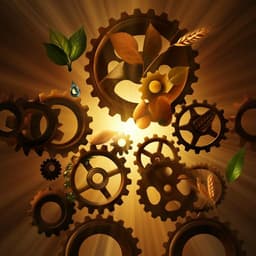
Environmental Studies and Forestry
Trees on smallholder farms and forest restoration are critical for Rwanda to achieve net zero emissions
M. Mugabowindekwe, M. Brandt, et al.
Explore the remarkable impact of smallholder farmers in Rwanda, who planted 50.4 million trees from 2008 to 2019, contributing to significant carbon sequestration despite lower gains compared to forest restoration. This study by Maurice Mugabowindekwe and colleagues reveals a path for integrating agroforestry into carbon markets, potentially offsetting 80% of national emissions by 2050.
~3 min • Beginner • English
Introduction
The study addresses how trees on smallholder farms and restoration of degraded forests contribute to Rwanda’s carbon sequestration and net zero emissions goals. Tree-dominated ecosystems support biodiversity, store carbon, and offer socio-economic benefits. Agroforestry—integrating trees within croplands—is increasingly adopted in the Global South for production diversification, soil fertility, and carbon storage. Natural forests provide high carbon stocks and biodiversity but face deforestation and degradation. Large-scale restoration often prioritizes agricultural land due to presumed ease of increasing tree cover, yet monitoring success in both degraded forests and farmlands is challenging with conventional satellites; individual trees are hard to quantify, and studies often rely on proxies like greenness that do not directly reflect tree cover or carbon. Smallholder farms (<10 ha) are frequently excluded from monitoring, leaving their restoration contributions underrecognized. This paper conducts wall-to-wall national mapping of individual trees (≥3 m² crown) in Rwanda in 2008 and 2019 to quantify changes in tree number, crown area, and aboveground carbon stocks, focusing on farmlands and degraded forests, and evaluates their potential to help Rwanda achieve net zero by 2050.
Literature Review
The paper situates its work within literature showing the climate mitigation and biodiversity value of trees and forests, the potential of agroforestry to enhance productivity and carbon storage, and the rapid carbon accumulation potential of regenerating degraded forests compared to old-growth. It highlights limitations of prior monitoring approaches that used medium- to coarse-resolution satellite proxies (e.g., greenness indices) which do not capture individual tree cover or carbon, especially in heterogeneous smallholder landscapes. Previous studies and national assessments in Rwanda informed definitions of land cover classes and recommended on-farm tree densities. The work also references global efforts and pledges for tree planting and forest restoration, debates on monoculture plantations versus natural forest restoration for climate and biodiversity benefits, and prior allometric models for estimating biomass and carbon from remote sensing-derived tree metrics.
Methodology
Data sources: Aerial imagery at 0.25 m resolution from 2008–2009 (Vexcel UltraCam-X) and WorldView satellite imagery at 0.5 m resolution for 2019 (provided by Rwanda Space Agency), both harmonized to 0.5 m, 8-bit RGB bands. Land cover delineations for degraded natural forests and farmlands derived from national forest cover and agricultural extent maps.
Pre-processing: Images resampled to 0.5 m; histogram matching applied to align radiometry; wetlands and cloud/shadow pixels masked via a UNet-based cloud detection model trained on 870 manual cloud delineations (1877 areas, 5219 ha). Masked areas (1.4% of farmland, 3.3% of degraded forest) were excluded without extrapolation.
Tree segmentation: Manually delineated 325,540 tree crowns (≥3 m²) to train a UNet segmentation model with boundary-weighted loss to reduce clumping. Training samples: 131,269 crowns over 4039 patches (2008) and 194,271 crowns over 7390 patches (2019), stratified across elevation and land cover types. Post-processing separated clumped crowns assuming round shapes by identifying crown centers and reassigning pixels via weighted distances.
Change detection: Tracked crown centers between 2008 and 2019; trees present only in 2019 classified as gains; only in 2008 as losses. Tree density defined as number of trees per hectare; canopy cover as percent crown area per hectare.
Validation: Independent test set of 52 patches (17,306 labeled trees) yielded, for 2008: r² = 0.84 (tree count), 0.89 (canopy cover), 0.78 (mean crown area), TPR 74%, FNR 26%, overall accuracy 95%; for 2019: r² = 0.71, 0.78, 0.72 respectively, TPR 77%, FNR 23%, overall accuracy 93%. Change validation used 296 permanent field plots with 4217 measured trees and planting years; mapping showed a consistent 7–9% underestimation relative to field counts.
Biomass and carbon estimation: Crown area converted to crown diameter; diameter at breast height (DBH) estimated via biome-specific equations; aboveground biomass (AGB) predicted from DBH; AGB to aboveground carbon (AGC) using conversion factor 0.47. Different equations applied for savannas/shrublands, plantations/farmlands/urban, and natural forests; wood density fixed at 0.54; environmental stress parameter used where applicable. Reported uncertainties: ~5.7% for farmlands and 33.4% for degraded forests (from referenced evaluation).
Farm-level analysis: Used 942,081 2019 land parcels (99.6% ≤5 ha; mean 0.18 ha) from the National Land Authority across four districts representing Rwanda’s major landscapes; quantified per-plot tree counts and carbon stocks; compared 2008 vs 2019.
Scenario and cost-benefit analysis: Three scenarios assessed assuming 2019 GHG emissions levels: (1) Business-as-usual (BAU) continuing observed annual tree density trends; (2) Achieve maximum farmer tree densities from literature and 70% of recommended density in degraded forests; (3) Achieve the Ministry of Environment’s recommended on-farm density (300 trees ha⁻¹) and 70% of field-measured maximum natural forest density for degraded forests (700 trees ha⁻¹). Costs based on national methodologies: agroforestry transition ~1200 USD ha⁻¹ over 20 years with 12–38% ROI excluding carbon credits; degraded forest restoration ~375 USD ha⁻¹ with carbon credit revenue approximately equal to costs. Assumed 70% seedling survival. Estimated potential carbon credits revenue using price ranges 10–100 USD per tCO₂.
Key Findings
- National-scale tree changes (2008–2019):
- Farmlands (agroforestry; ~1,316,389 ha, ~61% of Rwanda): trees increased from 77.7 million to 105.8 million; net gain ~28 million trees (+1.9 trees ha⁻¹ yr⁻¹); gross gain 50.4 million (+3.5 trees ha⁻¹ yr⁻¹), gross loss 22.3 million (−1.5 trees ha⁻¹ yr⁻¹). Tree density increased from 59 to 80 trees ha⁻¹.
- Degraded natural forests (~10,932 ha, ~0.5% of Rwanda): trees increased from 1.5 million to ~2.06 million; net gain ~0.55–0.6 million (+4.6 trees ha⁻¹ yr⁻¹); gross gain 0.76 million (+6.3 trees ha⁻¹ yr⁻¹), gross loss ~0.2 million (−1.7 trees ha⁻¹ yr⁻¹). Tree density increased from 138 to 188 trees ha⁻¹.
- Farm-level planting: Across 942,081 smallholder parcels, average trees per plot increased from 10.9 (SD 28.8) to 14.1 (SD 37.3); about 3.2 trees planted per plot (≈18 trees ha⁻¹). Nationally, farmlands gained on average 21 trees ha⁻¹ (SD 21.3).
- Carbon stocks and increments:
- Farmlands AGC: 5.2 ± 0.3 Tg C (2008) to 6.3 ± 0.36 Tg C (2019); net gain 1.1 Tg C (~0.09 Tg C yr⁻¹). New trees’ carbon density ~1.4 (SD 1.3) Mg C ha⁻¹ (~0.12–0.13 Mg C ha⁻¹ yr⁻¹).
- Degraded forests AGC: 0.38 ± 0.12 Tg C (2008) to 0.79 ± 0.26 Tg C (2019); net gain 0.42 Tg C (~0.038 Tg C yr⁻¹). New trees’ carbon density ~8.4 (SD 8.4) Mg C ha⁻¹ (~0.76 Mg C ha⁻¹ yr⁻¹).
- Combined annual net C sink (farmlands + degraded forests): ~0.13 Tg C yr⁻¹ (2008–2019).
- Emissions offsets and economics:
- Rwanda’s 2019 GHG emissions: ~1.4 Tg C (CO₂, CH₄, N₂O). Trees in farmlands and degraded forests offset ~10% of annual emissions during 2008–2019.
- Social cost of CO₂: 2019 emissions imply ~943.5 million USD in social damages; offsets correspond to ~88.2 million USD avoided damages.
- Potential carbon credit value for farmland CO₂ offsets: ~3.7–36.7 million USD per year (10–100 USD per tCO₂).
- Spatial patterns: 46% of farmland carbon gains in central plateau, 29% in humid western highlands, 25% in eastern drylands (which also had highest losses).
- Future potential (recommended combined scenario: agroforestry at 300 trees ha⁻¹; degraded forests at 700 trees ha⁻¹):
- Annual C gain ~1.1 Tg C yr⁻¹ (0.96 Tg from agroforestry; 0.15 Tg from degraded forests), equivalent to ~80% of 2019 national GHG emissions, with remaining ~20% potentially covered by preserving natural forests (~5% of area, >50% of national C stocks).
- Over 20 years: ~294.6 million new trees (assuming 70% survival), adding ~23.5 Tg C (farmlands) and ~3.0 Tg C (degraded forests). Estimated total investment ~1.163 billion USD; ROI 140–442 million USD from productivity/erosion benefits plus ~33–330 million USD from carbon credits.
Discussion
The study demonstrates that both agroforestry expansion on smallholder farms and regeneration of degraded natural forests can substantially contribute to Rwanda’s carbon sink and its net zero target. Degraded forests exhibit much faster carbon accumulation per hectare than farmlands, highlighting the importance of protecting and restoring natural forests for climate mitigation and biodiversity. However, farmlands cover a far larger share of Rwanda’s territory, so even modest per-hectare gains aggregate to significant national-scale carbon benefits. The observed average planting of ~3.2 trees per smallholder plot underscores the cumulative impact of smallholders, whose contributions are often overlooked due to monitoring limitations. By mapping individual trees across the nation and quantifying their carbon, the study provides a path for robust monitoring, reporting, and verification (MRV), enabling inclusion of smallholders in carbon markets and informing targeted restoration strategies. Scenario analyses suggest that achieving recommended tree densities in agroforestry systems alongside restoring degraded forests could offset ~80% of 2019 national emissions, especially when combined with preserving existing natural forests. The findings support policy measures that encourage farmer engagement in agroforestry, invest in forest restoration, and develop fair frameworks for carbon credit transactions linked to verifiable, tree-level carbon gains.
Conclusion
This work introduces a nation-wide, tree-level mapping approach using very high-resolution imagery and deep learning to quantify changes in tree numbers, canopy, and aboveground carbon stocks in Rwanda’s farmlands and degraded forests between 2008 and 2019. It shows substantial gains in trees and carbon, with degraded forests sequestering carbon much faster per hectare than farmlands, and smallholder farms collectively adding over 50 million new trees. The study provides robust evidence and scenarios indicating that achieving recommended tree densities in agroforestry and restoring degraded forests could offset up to ~80% of Rwanda’s current annual GHG emissions before 2050, with viable economic returns and additional potential from carbon credits. The methodological framework offers a scalable MRV tool to monitor restoration progress, support policy and investment decisions, and facilitate smallholder participation in carbon markets. Future research should integrate higher temporal coverage, improved structural metrics (e.g., LiDAR height), and comprehensive econometric analyses to refine forecasts and tailor interventions to social and landscape contexts.
Limitations
- Dependence on image quality and availability: cloud and shadow masking led to exclusion of 1.4% (farmlands) and 3.3% (degraded forests) of areas without extrapolation, potentially omitting localized changes.
- Allometric and parameter uncertainties: errors from estimating DBH from crown diameter, AGB from DBH, fixed wood density, and biomass-to-carbon conversion propagate to carbon estimates; uncertainties are higher in degraded forests (~33.4%) than farmlands (~5.7%).
- Segmentation and detection biases: consistent 7–9% underestimation relative to field plots; challenges remain in separating clumped crowns and detecting small/young trees.
- Simplified scenario assumptions: uniform survival rates (70%), constant 2019 GHG emissions, and homogeneous costs/benefits ignore social, ecological, and management variability across landscapes.
- Limited structural data: absence of height (e.g., LiDAR) and species-specific wood density reduces accuracy of biomass estimates.
- Transferability: application to other regions may require adaptation and access to comparable high-resolution, multi-temporal imagery and local calibration data.
Related Publications
Explore these studies to deepen your understanding of the subject.







